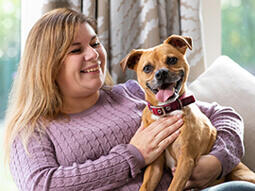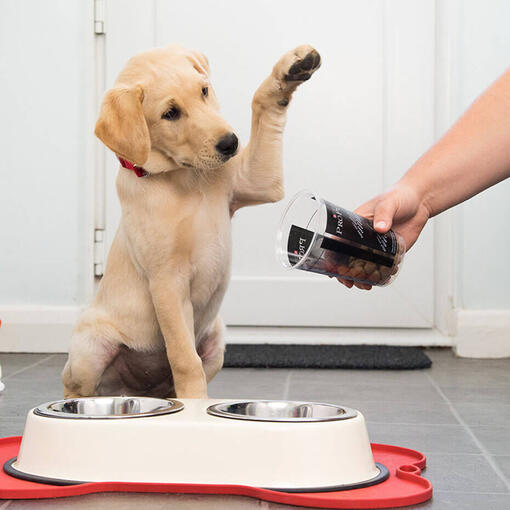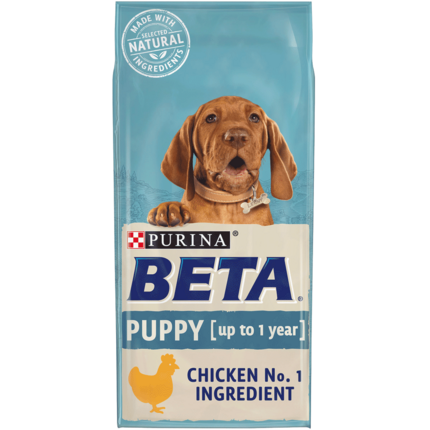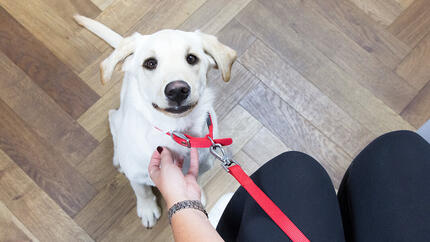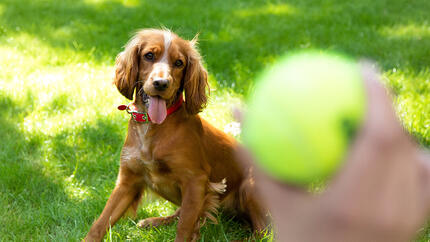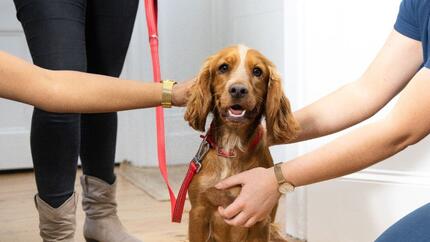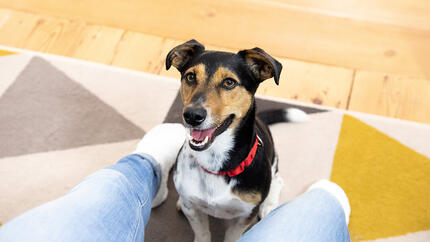

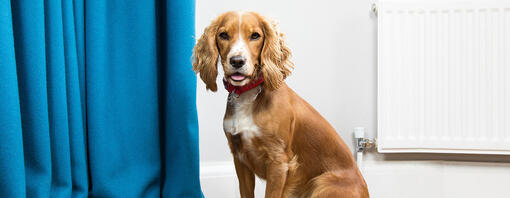
Dog puberty usually occurs when your pup is between 6 months and 2 years old and as with humans, it can bring a whole load of behavioural and physical changes. Find out everything you need to know about the signs of puberty in puppies and what you can expect in this handy guide.
There is one thing that all puppy owners can rely on – and that is that their lovely cute, biddable puppy will one day grow up to be a canine adolescent, which brings with it both behavioural and physical changes.
When does dog puberty occur?
Dog puberty is the period between sexual maturity and social maturity and can happen between around six months to almost two years, depending on the breed (larger breeds take longer to develop). Another way of looking at it is as a time when their hormones are running ahead of their brains – pretty much like with human teenagers!
Behavioural changes during dog puberty
During this stage of dog puberty, one of the first things you may notice is that your puppy’s behaviour starts to change. Things that you have taught them may seem to be inadvertently forgotten and they appear to ‘forget’ the simplest things, whether this is toilet training, recall or walking nicely on the lead. There may be changes in their interactions with you as they become clingier or, at other times, the puppy who used to hang on your every word seems not to notice you even exist!
This is a time when your puppy is starting to look at the world through the eyes of an independent adult and reassess their behaviour strategies. You may see your puppy behaving fearfully or reacting to things they have apparently taken in their stride in the past.
Other dogs start to treat them differently, as they no longer have the ‘puppy privileges’ they used to enjoy. They have to rethink their social skills at a time when their hormones are raging as according to Pet Medical Center, an adolescent male dog has much higher testosterone levels than adult male dogs! This can lead to competitiveness and even aggression.
Their usual behaviours and personality can also seem exaggerated during dog puberty, for example puppies who may have been a little reserved can now become very shy, while the bold ones can become overly confident.
Physical signs of dog puberty
You may decide not to get your dog neutered, or have decided to neuter after they’ve entered their adolescent period, in which case it is important to understand the physical changes occurring in both male and female dogs at this time.
Female dog puberty symptoms
A female dog’s first heat will usually start at between six to 15 months of age, then once they’re mature, will occur approximately every seven months. A useful indicator to estimate when your dog’s first heat will be is to ask the breeder how old your bitch’s mother was when she first came into season.
The entire season usually lasts 3-4 weeks from beginning to end. The first physical signs you tend to see are a degree of swelling or redness of the vulva, a small amount of clear discharge and some increased licking of the area. You may notice your bitch needs to urinate more, or urinates more often when out. Other dogs might also begin to take an increased amount of interest in her, although she will not allow mating at this point and may even be quite aggressive if approached in this way by a male dog. This period can last 4-14 days (and on average about 9 days), and is called ‘pro-oestrus’.
Do dogs have periods?
In sorts, yes, dog’s do have periods. After the pro-oestrus stage, the female will enter the oestrus stage – which lasts around 9 days. During this time, you may notice more vulval swelling, enlargement of the mammary glands and bloody discharge, which can vary from just a few spots to a constant trail.
During the oestrus stage, she will be highly fertile and ready (sometimes extremely keen!) to breed. Males will also show even more interest in her than they would previously have done. It is worth being cautious both during this phase and for a few days after all signs of the season have passed, as otherwise, if your female is mated, she can still become pregnant - even if it’s only your dog’s first season.
Walking earlier/later when there are far fewer dogs around is important during this period, as well as keeping her on a lead at all times, as she will be attractive to other male dogs.
No feeding changes will be needed although due to the hormonal changes, you may notice a mild change in appetite in your dog, but this is not something to be overly concerned about. Be aware that there may be some discharge from the vulva and blood so you might want to avoid taking her into certain areas (such as carpeted floors!) or it may mean that it’s not appropriate for her to do activities such as going into work with you if you have a Pets At Work policy.
As the physical signs of oestrus subside, you may notice that your dog starts to become clingy or restless due to the hormonal changes.
False pregnancy in dogs
False pregnancy in dogs is quite common, also known as a ‘pseudopregnancy’, or a ‘phantom pregnancy’, it’s a condition where her body feels like it is pregnant, even though she is not. If this occurs, it tends to happen about 10-12 weeks after the end of her season. She may display the following symptoms:
- Whining and will appear obviously distressed.
- Nesting – she’ll probably try and nest anywhere and everywhere.
- She may become possessive of objects or toys and might also carry these around like babies.
- Increased clinginess.
- Decreased appetite.
- Milk production.
- Mammary enlargement.
- Milky vaginal discharge.
- Anorexia.
Luckily, false pregnancy in dogs does pass (normally between 1-2 weeks), and usually no treatment is needed, although if she shows severe aggression or very obsessive nesting behaviour your vet may advise some medical management. You can help by removing the objects she is attempting to ‘nurse’ or nest with, and thereby stop the association she is having with mothering-style behaviour, and ensure you keep her busy and occupied with exercise, enrichment and activities. It is worth being aware that often once false pregnancy in dogs starts, she is very likely to have them each season.
Male dog puberty symptoms
Males do not have a season like bitches, and once sexually mature they can breed all the time, although are at their most fertile between around 12-18 months old.
Usually, the testicles in a male puppy will descend into the scrotum very shortly after birth but sometimes they may take over one month and, very rarely, up to 1 year (although usually they have descended by 3 months of age when you take your puppy for his second vaccine). Once the testicles descend and his testosterone levels begin to rise, the puppy will start to lift their leg to urinate. The increased hormones can sometimes lead to behavioural changes including aggression, but these are very variable and differ between individual dogs.
Now you know everything you need to know about dog puberty! Looking for more puppy advice? Read our puppy adolescence article.

